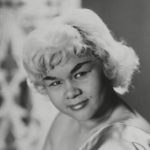
Born: January 25, 1938
Died: January 20, 2012
Etta James was born Jamesetta Hawkins in Los Angeles in 1938. James’s mother was still a high school student when she was born, and she was largely raised by an aunt and then by a foster family. At five years old, she began singing at the St. Paul Baptist Church, famous for its Echoes of Eden gospel choir. She began taking voice lessons from the choirmaster, James Earle Hines, and piano lessons from his wife. “In the forties,” writes James in her autobiography, “word got out that a girlchild in the St. Paul Baptist could sing like a full-grown woman, with grown-up feelings and strength. Joe Adams’s radio broadcasts helped spread the news, and it didn’t take long before I was famous.”
When her foster mother died, James moved to San Francisco to live with her birth mother and other relatives. Life became unstable, and James struggled in school and personally. She writes about music in her teenage years as both a coping mechanism and an expression of rebellion: “I liked the blues and the feeling it gave me,” she told the Los Angeles Times in 1992. “It gave me a naughty-girl feeling.” James particularly enjoyed modern jazz as well as the many vocal groups, black and white, popular in the early fifties. One such group, Hank Ballard & the Midnighters, provided the impetus for James’s first song: at fourteen years old, she wrote “Roll with Me, Henry” as an answer song to “Work with Me, Annie.” When Johnny Otis heard her perform it with her group the Creolettes, he invited the girls to tour and record with him. Teenage James forged her mother’s signature on a permission slip and ran away to Los Angeles with Otis. Her song, retitled “The Wallflower” to make it more appealing to radio stations, topped the R&B charts in 1955. A cover version by Georgia Gibbs, re-retitled “Dance with Me Henry,” became a #1 pop hit.
James continued writing and recording songs for Modern Records. “Good Rockin’ Daddy,” which she described as “another primitive example of strong early rock,” cemented her status as an R&B star. She began touring widely—usually with her mother as her chaperone—appearing alongside stars including Little Willie John, Faye Adams, Hucklebuck Williams, the Clovers, and Little Richard. She also went to New Orleans to record at Cosimo Matassa’s studio, using many of the same session musicians who played on Fats Domino’s records. It was also during the mid-fifties when she adopted her trademark platinum blonde hair, wanting an edgy look to match her sound: “I didn’t want to look innocent,” writes James. “I wanted to look like Joyce Bryant. Joyce Bryant was this sexy black singer—a good singer—who poured herself into fishtail gowns. They called her the Brown Bombshell and she caught all kinds of hell for having blond hair. I dug her.”
James kicked off the 1960s working for Chess Records in Chicago. She wrote songs for the label and sang backing vocals, including for Chuck Berry. James, however, grew less interested in recording rock and roll. “I was tired of being ripped off by the Georgia Gibbses of the world,” she writes, “tired of doing quickie teenage rockin’, humping, and bumping ditties. Besides, I was no longer a teenager. I was twenty-two and sophisticated.” Working with Harvey Fuqua, she grew increasingly interested in jazz standards. It was during this time that she recorded her signature hit, “At Last,” and began to see crossover success on the charts.
James continued to record with Chess for the next fifteen years—and was a semi-regular presence on the R&B charts into the 1970s—and later worked with producers Jerry Wexler and Allen Toussaint. Her personal life, however, remained tumultuous. She struggled with addiction (heroin at first, later cocaine and codeine) and committed check fraud; she served jail time, spent seventeen months living in a psychiatric hospital in the early 1970s, and checked herself into the Betty Ford Clinic in the 1980s.
In the 1980s, the stories about James in the media begin to show a career renaissance taking place. She opened for the Rolling Stones (at the request of Keith Richards), sang in the opening ceremonies for the 1984 Olympics, and appeared in Chuck Berry’s 1987 documentary/concert film Hail! Hail! Rock ’n’ Roll. She also returned to the studio in 1989 with her first new album in nearly seven years, thereby titled Seven Year Itch.
James received a number of honors before her death of leukemia in 2012. She was inducted into the Rock and Roll Hall of Fame in 1993, and her recording of “At Last” was included in the GRAMMY Hall of Fame in 1999. In 2008, Beyoncé portrayed James in Cadillac Records, a biopic about Leonard Chess.
Etta James and the Peaches, “The Wallflower” / “Hold Me, Squeeze Me.” Modern 45×947 (1955).
Etta James, Maxwell Davis & Orch., “Good Rockin’ Daddy” / “Crazy Feeling.” Modern 45×962 (1955).
“She’s No Paula Abdul: There’s Nothing Diminutive About R&B Diva Etta James,” Los Angeles Times, 16 January 1992.
Richard Cromelin, “Etta James Climbs Back on Top of the Blues,” Philadelphia Inquirer, 5 January 1993.
Etta James and David Ritz, Rage to Survive: The Etta James Story, 2nd ed. (Da Capo, 2003).
Nekesa Mumbi Moody and Robert Jablon, “Blues Singer Etta James Dies,” Associated Press, 22 January 2012.
